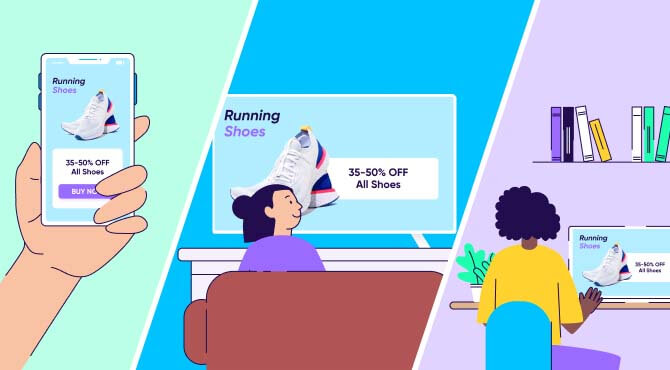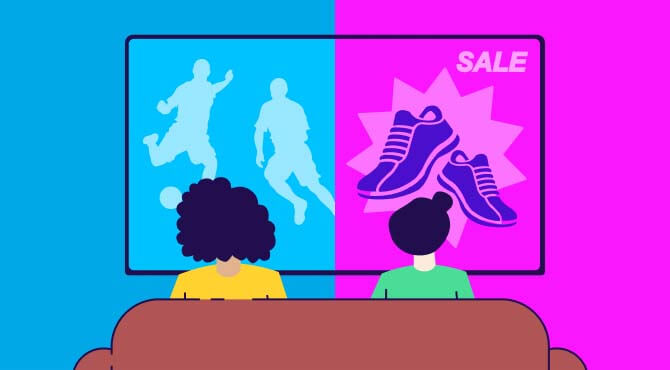
Programmatic TV

Programmatic TV is a way of buying ad spots using automated technology.
What is programmatic TV?
Programmatic TV is a data-driven, technology-automated method of purchasing and delivering advertisements against television content. This includes:
- Digital TV ads served across mobile devices
- Video-on-demand streaming platforms (like Netflix and Amazon Prime)
- Connected TV (such as Apple TV and Amazon Fire TV)
- Linear TV advertisements served across set-top boxes (think Comcast and Time Warner)
Programmatic TV inverts the industry standard, in which television marketers rely on show ratings to find desirable audiences for their advertisements. Traditionally, the bigger the show, the more people you reach — and therefore, the more coveted (and expensive) the spot.
Instead, programmatic technology uses audience data to achieve much more detailed segmentation, so TV marketers can reach a more specific subset of consumers — for example, men with a $40,000 income who own an iPhone device.
Marketers don’t care if that advertisement shows up on X Games or The X Factor, as long as their ideal audience is watching.
What is programmatic advertising?
Programmatic advertising refers to the use of software to purchase digital ads. While the conventional method includes requests for quotes, tenders, proposals, and negotiation, programmatic ad buying uses algorithmic software to buy and sell online ad display space.
This model helps connect publishers (individuals with ad inventory to sell) and advertisers (individuals or companies who want to buy that ad space to promote their brands). It involves a distinctive approach to TV service scaling, ad buying, and delivering. Advertisers can quickly search for their chosen audience and successfully deliver a personalized advertisement to them.
Advertisers and marketers can carry out an automated in-depth analysis of end users or consumers and personalize ad content to create a successful advertising marketing model. Publishers and distributors, in turn, can deliver television program formats based on viewer preferences and parameters, such as gender and age (the primary audience measurements in most TV purchases).
Programmatic buying models
There are four main types of programmatic ad buying. Let’s dig into how each one works and when it’s best used.
1. Real-time bidding

With real-time bidding (also called open marketplace), advertising spots are open to the public. This means anyone can bid on any location, over the internet in real-time.
Bidders can buy these advertising spots through an open auction. If you’re the highest bidder, you get the location, but you won’t pay your highest bid amount. Instead, you’ll be charged $0.01 higher than the second-highest bidder for the same ad spot.
The downside is that you won’t know where your ads will appear — and they could show up in less-than-ideal locations.
2. Preferred deals

Preferred deals allow you to choose ad spots before they go on real-time bidding auctions or private marketplaces — ideal if you want a preview of the available ad space.
If you choose this option, you need to pay a fixed price for ad space (known as spot buying). When advertisers want to pay for an ad location on a publisher’s website, both parties agree on audience, pricing, and more before the spot is claimed.
3. Private marketplace
The private marketplace operates on an invitation-only basis, meaning publishers offer their premium ad spots to a select list of advertisers. Publications and websites with massive amounts of reach typically use this approach. These platforms have plenty of brands vying for ad space, so they can afford to reserve spots for top-notch advertisers.
With a private marketplace, you always know where your advertisements will appear. It eliminates the mystery of ad placement you get with the real-time bidding option.
4. Programmatic guaranteed
This option takes the conventional approach to media buying. Publishers and advertisers negotiate the terms of the ad spot on a one-on-one basis, which means there’s no bidding involved.
With the programmatic guaranteed approach, an advertiser can choose their price, their ideal audience and how frequently their advertisements appear. This option offers the most flexibility to advertisers, but it comes at a price. You’ll need a bigger budget if you want this level of control over your ad’s exact cost and placement.
Benefits of programmatic TV
The global programmatic ad spending market is expected to grow by about $314 billion during 2022-2026, or around 26% per year. This sustained growth comes down to the following benefits that programmatic TV offers above and beyond conventional media buying.
More reach
A programmatic TV platform allows advertisers to easily connect and work with local broadcasts. Brands can then tap into a massive amount of reach, especially in small and mid-sized markets.
This platform also helps publishers get to national brands or companies. With clients lining up for ad spaces, local TV stations can offer their inventory at high prices. Since programmatic TV introduces end-to-end workflow, it makes the process easy for both advertisers and publishers.
More data
As mentioned earlier, programmatic TV incorporates new data sources with more width and depth, so you can deliver more personalized and relevant ads Multiple data sets (including publicly available social data and set-top box viewership) work together to help clearly define the behavioral traits of a potential brand and maximize an ad campaign’s performance.
Fewer errors
Manual, complex processes — such as creating a media buying agreement, turning it into a schedule, and then putting that into a legacy delivery system — often cause errors at reconciliation stages. Eliminating these time-consuming and costly practices benefits both advertisers and ad spot sellers.
A programmatic solution means availability requests, proposals, and orders can all be automated. It can empower advertisers to reserve ad spots across multiple local stations from a single dashboard. Meanwhile, inventory owners trying to prevent money from being siphoned out by digital can modernize and streamline their workflows.
Disadvantages of programmatic TV
Programmatic TV depends on a flexible, granular data model that helps service providers, television producers, and brands manage and market their products or services. However, it’s certainly not without its faults — here are some of the downsides to bear in mind.
Cost
Programmatic TV is usually more expensive than conventional advertising because it’s more personalized. The detailed level of audience segmentation needs more setup and analysis. For example, you may need to manually input specific targets.
Data quality
Programmatic TV data may not always be valid and recent. Also, it’s challenging to determine where the data comes from and if you’re really reaching the right audience. Even if you are, there’s no guarantee they’ll convert. You may assume that more personalization equals more conversions. That’s not necessarily true because the data quality may not be accurate.
Network uptake
There’s a current fear that the value of television networks’ inventory will go down and commoditize if they make anything programmatic public. This makes networks nervous, meaning that many of them haven’t yet adopted a programmatic model.
Programmatic CTV, programmatic linear TV, addressable TV: what’s the difference?
There are several ways of delivering TV ads to a household, including programmatic CTV, programmatic linear TV, and addressable TV. Here’s a closer look at each method.
Programmatic CTV
CTV (click-to-view) advertising is a type of digital advertising that appears within streaming content. For instance, it includes advertisements shown alongside live streams or TV shows viewed on streaming devices. Another example is interactive advertisements, which are shown to a particular audience and include calls to action.
Programmatic linear TV
Programmatic linear TV is an automated approach to the conventional buying and execution of TV ads in spot-based programming. It enables advertisers to segment their audience at user level or media level.
Addressable TV

With addressable TV, marketers can offer customized advertisement experiences to various audience segments.
Addressable TV depends on audience data being safely collected and matched to their IP addresses. By identifying the websites people visit, the devices they own (and their cross-device behavior), the times when they watch television, and of course, the shows or programs they’re interested in, marketers can create incredibly detailed consumer profiles.
Programmatic TV vs. addressable TV
Addressable TV uses advanced audience segmentation and programmatic technology to deliver specific video advertisements at a household level in real time.
This is what makes addressable TV stand out from programmatic TV, even though they both leverage automation to serve television ads. It means marketers or advertisers can now buy audiences rather than programs — similar to the programmatic video and display buying processes used on mobile and desktop devices.
Unlike standard programmatic television advertising, addressable TV doesn’t require advertisers to pre-select availability. Also, they don’t need to predict who will be watching, as the system determines audience composition in real time and then selects the most appropriate advertisements. This means each advertiser reaches only those audiences that qualify. Segmentation can occur at demographic, geographic, and behavioral levels.
What does the future look like for programmatic TV?
Programmatic TV is still in its infancy, and we’ve seen how it’s forecast to grow. Here are some key trends to look out for in the years to come.
Ad fraud detection
Programmatic CTV is disrupting the ad space with advanced technologies, such as artificial intelligence (AI) and machine learning (ML). Already, people are seeing how the influx of data that AI provides is helping marketers to reach the right audience with the right message at the right time. This will only continue to rise.
We’ll also see tech advancements to improve fraud detection in the programmatic space. The number of cases related to CTV advertising scams has been rising: in the fourth quarter of 2021, about 18% of the unprotected programmatic CTV advertisements were fraudulent or invalid traffic. Going forward, you’re bound to see the rise of technologies that reduce or even eliminate these threats.
Increased spending and viewership
As television viewers become increasingly unsatisfied with the high cost of conventional TV, cord-cutting is growing. In the United States alone, big cable providers collectively lost around 6 million pay-TV subscribers between 2019 and 2021.
Key takeaways
- Programmatic TV is the automation of audience-based television advertising through a software platform. It presents an opportunity for advertisers to better segment their audience and show them more personalized ads.
- Programmatic advertising makes it possible to buy and place advertisements, including targeted ad content, in less than a second. It uses algorithms to determine where and when to deliver content to specific consumers.
- Buying ads across multiple ad exchanges allows advertisers to expand their reach beyond conventional means.
- This model also provides you with more data, and has fewer errors compared to conventional media buying. However, it’s more expensive than traditional advertising.
- Programmatic advertising isn’t yet used by all networks, but is growing fast as the technology advances.



